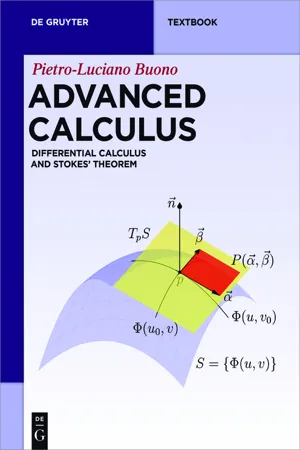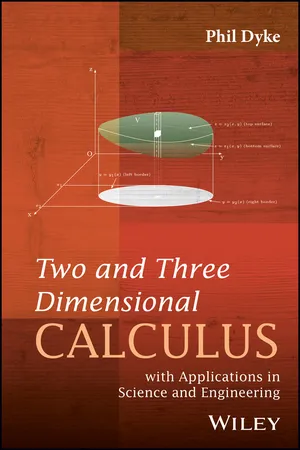Technology & Engineering
Triple Integrals
Triple integrals are mathematical tools used to calculate the volume of a three-dimensional object. They involve integrating a function over a three-dimensional region, with each integral representing a different dimension. Triple integrals are commonly used in fields such as physics, engineering, and computer graphics.
Written by Perlego with AI-assistance
Related key terms
2 Key excerpts on "Triple Integrals"
- eBook - ePub
- Pietro-Luciano Buono(Author)
- 2016(Publication Date)
- De Gruyter(Publisher)
7 Double and Triple Integrals
This chapter is concerned with the definitions of double and Triple Integrals as well as practical formulae for their computation. However, we begin with a section introducing a new concept called the wedge product which we apply to differentials. The wedge product is useful to compute areas and volumes and form the backbone of the definitions of double and Triple Integrals. The second section is about the double integral and may be considered as review for some readers, except for the last part of the section where we discuss Green’s theorem. This theorem links the computation of line integrals of 1-forms to double integrals and is considered one of the fundamental theorems of vector calculus, the second presented in this text after Theorem 4.3.5. The final section discusses the triple integral over boxed and more general domains.7.1 Area and Volume Forms
We show in Chapter 1 , Section 1.5 that curves can be given an orientation. We generalize the construction to higher dimensional spaces and surfaces. We say that ℝ2 is positively (negatively) oriented if angles increase when rotating around the origin in the counterclockwise (clockwise) direction. This means that when defining polar coordinates in the typical way, we are giving ℝ2 a positive orientation.Orientations of ℝ3 are obtained as follows. Choose a positive orientation of ℝ2 with axes x and y and let the z axis be perpendicular to the x, y -plane. If the positive numbers of the z axis point up, we say that ℝ3 has positive orientation, otherwise, it has negative orientation. One can give a positive and negative orientation to ℝn for any n inductively by choosing a positive orientation for ℝn-1 , then the orientation of thexnaxis determines a positive or negative orientation of ℝn . However, it is not possible to visualize the orientation in dimensions higher than three. In Chapter 10 , we define orientations for two-dimensional surfaces in ℝ3 - eBook - ePub
Two and Three Dimensional Calculus
with Applications in Science and Engineering
- Phil Dyke(Author)
- 2018(Publication Date)
- Wiley(Publisher)
Chapter 9 Multiple Integrals 9.1 Introduction Integration, as introduced previously, is the inverse of differentiation. Usually, the integral is interpreted as the area under a curve. For example, is the area under the curve between the values and. This works well provided in the range. In the last chapter, the path or line integral was introduced. Although the integration of this chapter is still the inverse of differentiation, it is not restricted to either finding areas under curves or indeed path integrals. As a starting point, it is best to think of a pixel on a screen moving first one way to describe a line, then the line moving at right angles to encompass an area. This way a domain is covered, and the magnitude of areas are calculated. Move in three perpendicular directions and volumes can also be calculated. Importantly, so much more than areas and volumes can be found in this way. For those more interested in mechanics, quantities such as the centre of mass and the moment of inertia can be found. For the statistically inclined, there are probability distributions defined over an area that occur in experimental design, for example. It is also possible to use co-ordinate systems other than Cartesian: plane polars in two dimensions and cylindrical and spherical polars in three dimensions. Given the new material, even though vectors could be involved here, a decision has been made to keep this chapter clear of vectors. We start with double integrals. 9.2 The Double Integral Figure 9.1 shows a typical region in the plane. The small black rectangular area is shown and the idea is that the expression should be uniquely defined. First of all, the integrand is an integrable function of both and. Functions that are piecewise continuous throughout and on the domain will suffice. The limits are defined to indicate the domain. Take a look at Figure 9.1. The small black rectangle has sides and
Learn about this page
Index pages curate the most relevant extracts from our library of academic textbooks. They’ve been created using an in-house natural language model (NLM), each adding context and meaning to key research topics.

